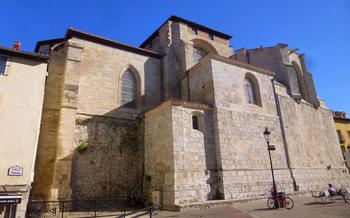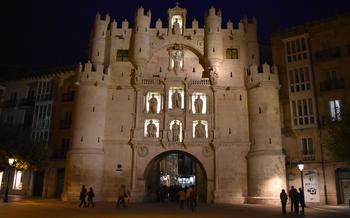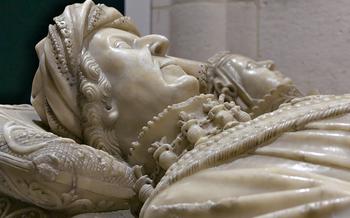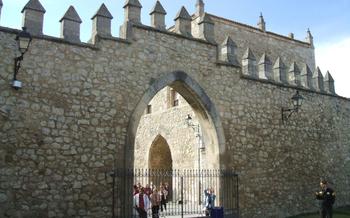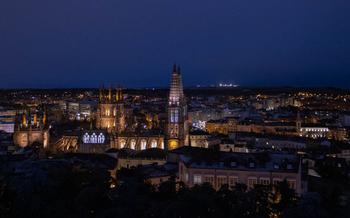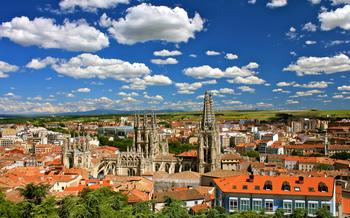
Pozo de San Atilano
- The Pozo de San Atilano: A Hidden Gem in Burgos
- Location and Accessibility:
- Entry Fees and Hours of Operation:
- Historical Background
- The Legend of the Miracle
- Religious Significance
- Cultural Importance
- Restoration and Conservation:
- Nearby Attractions
- Accessibility for Visitors with Disabilities:
- Photography and Videography
- Souvenirs and Mementos:
- Insider Tip:
The Pozo de San Atilano: A Hidden Gem in Burgos
In the heart of the historic city of Burgos, Spain, nestled amidst narrow cobblestone streets and medieval architecture, lies a hidden gem waiting to be discovered: the Pozo de San Atilano. This ancient well, steeped in religious and cultural significance, offers a unique and awe-inspiring experience for visitors seeking a glimpse into the rich history and traditions of the region.
The Pozo de San Atilano is an octagonal well with a remarkable history dating back to the 10th century. According to legend, it was here that Saint Atilano, the patron saint of Burgos, performed a miraculous healing, restoring the sight to a blind man. This event propelled the well to prominence as a site of pilgrimage and devotion, attracting countless believers seeking divine intervention and healing.
Over the centuries, the Pozo de San Atilano has become an integral part of Burgos' cultural heritage. Its unique architecture, with its striking octagonal shape and intricate carvings, sets it apart from other wells in Spain. The well's water is said to possess healing properties, and many locals and visitors alike partake in the tradition of drinking from it for good luck and protection.
Location and Accessibility:
The Pozo de San Atilano is situated in the heart of the historic city of Burgos, a captivating destination in northern Spain. To reach this hidden gem, head to the Plaza del Rey San Fernando, a charming square located just a short walk from the iconic Burgos Cathedral. Once there, you'll find the well nestled within the Iglesia de San Gil Abad, a beautiful church that dates back to the 14th century.
When planning your visit, consider utilizing public transportation, as it offers a convenient and eco-friendly way to explore the city. Several bus lines stop near the church, making it easy to get there without the hassle of finding parking. Alternatively, if you prefer the flexibility of driving, there are limited parking options available in the surrounding streets.
To avoid crowds and enjoy a more tranquil experience, it's advisable to visit the Pozo de San Atilano during the off-season or on weekdays. However, if you happen to visit during peak tourist season, be prepared for a moderate number of visitors, especially during the summer months. Embrace the opportunity to share this unique site with fellow travelers and immerse yourself in the lively atmosphere.
Entry Fees and Hours of Operation:
Visiting the Pozo de San Atilano is free of charge, allowing everyone to experience its historical and cultural significance without financial barriers. This open-door policy encourages locals and tourists alike to explore this hidden gem and immerse themselves in its unique atmosphere.
The Pozo de San Atilano follows specific opening hours to ensure proper maintenance and preservation. It is generally accessible to the public from 10:00 AM to 2:00 PM and from 4:00 PM to 7:00 PM on weekdays, excluding holidays. On Saturdays, it remains open from 10:00 AM to 2:00 PM, providing ample time for visitors to explore this sacred site.
To avoid crowds and fully appreciate the tranquility of the well, it is advisable to plan your visit during the early morning or late afternoon hours. This allows you to soak in the serenity of the surroundings and truly connect with the spiritual essence of the Pozo de San Atilano.
Historical Background
The Pozo de San Atilano is steeped in history and legend, with a deep connection to the life of Saint Atilano, the patron saint of Burgos. Born in the 9th century, Saint Atilano dedicated his life to serving the people of Burgos, becoming known for his generosity, compassion, and unwavering faith.
According to legend, during a severe drought that threatened the city, Saint Atilano prayed fervently for divine intervention. In response to his prayers, a miraculous well appeared, providing a steady supply of fresh water to the thirsty citizens of Burgos. This miraculous event solidified Saint Atilano's reputation as a holy man and cemented the well's importance in the city's history.
Over the centuries, the Pozo de San Atilano has become a place of pilgrimage and devotion, attracting visitors from far and wide who seek healing and spiritual solace. The well's water is believed to possess healing properties, and many pilgrims have claimed to have experienced miraculous cures after drinking from it.
The well has also played a significant role in the cultural and social fabric of Burgos. It has been featured in local folklore and literature, and its image has been used in various artistic representations throughout the city. The Pozo de San Atilano stands as a testament to the enduring legacy of Saint Atilano and the deep faith of the people of Burgos.
The Legend of the Miracle
The Pozo de San Atilano is steeped in legend and folklore, with the most famous tale being that of the miraculous healing of a blind man. According to legend, a blind man named Juan de Ortega was passing through Burgos when he heard about the well's healing properties. Desperate for a cure, he bathed his eyes with the water from the well and was miraculously restored to sight. News of the miracle spread throughout the region, and the Pozo de San Atilano became a place of pilgrimage for those seeking healing and divine intervention.
The legend of Juan de Ortega's miraculous healing is a testament to the power of faith and the enduring belief in the healing properties of the well. It is a story that has been passed down through generations and continues to inspire hope and devotion among visitors to this sacred site. The miracle is also depicted in a beautiful stained glass window in the church of San Gil, a fitting tribute to the enduring legacy of this remarkable story.
Religious Significance
The Pozo de San Atilano holds a profound religious significance for the people of Burgos and beyond. It is revered as a place of pilgrimage and devotion, attracting believers from all walks of life who seek spiritual guidance and healing. The well's water is believed to possess miraculous healing properties, and many have attributed their recoveries from illnesses and ailments to its divine touch.
A tradition associated with the well is the practice of drinking its water as a form of purification and blessing. Devotees often line up to partake in this ritual, seeking solace and renewal. The well's water is also used in religious ceremonies and processions, further emphasizing its sacred nature.
The Pozo de San Atilano has become an integral part of the local Catholic tradition. It is often visited by pilgrims who come to pay homage to Saint Atilano and seek his intercession. The well is also a popular destination for religious groups and organizations who hold prayer services and other devotional activities at the site.
Cultural Importance
The Pozo de San Atilano is deeply intertwined with the cultural fabric of Burgos. It serves as a gathering place for locals and tourists alike, embodying the city's rich heritage and traditions. The well is a frequent backdrop for local festivals and celebrations, notably the annual Fiesta de San Atilano. This vibrant festival honors the city's patron saint, with processions, concerts, and traditional dances filling the streets.
Moreover, the Pozo de San Atilano has permeated local folklore and literature. Countless stories, legends, and poems have been inspired by its mystical aura. One popular tale speaks of a young woman who was miraculously cured of her blindness after drinking from the well's holy waters. This legend has become deeply embedded in the local culture, underscoring the well's profound significance.
Recognizing its cultural importance, the city of Burgos has made concerted efforts to preserve and promote the Pozo de San Atilano's heritage. The site has been designated as a Bien de Interés Cultural, a protected cultural asset of national importance. Ongoing restoration and conservation projects aim to safeguard the well's historical integrity and ensure its preservation for future generations.
Restoration and Conservation:
The Pozo de San Atilano has undergone several restoration and conservation efforts throughout its history. The first major restoration was carried out in the 16th century, when the well's structure was reinforced and the surrounding area was landscaped. In the 19th century, the well was again restored, and the octagonal structure was rebuilt using more durable materials. The most recent restoration took place in the 1990s, when the well was thoroughly cleaned and the surrounding area was made more accessible to visitors.
One of the challenges in preserving the Pozo de San Atilano is the need to balance the site's historical integrity with the need to make it accessible to visitors. The well's octagonal structure is a unique and important feature, but it also makes the well difficult to access for people with disabilities. In recent years, efforts have been made to make the site more accessible, including the installation of ramps and handrails.
Ongoing projects and initiatives are underway to protect the well for future generations. These projects include the monitoring of the well's water quality, the repair of any damage to the structure, and the promotion of the site's cultural and historical significance. By working together, the local community and government officials are ensuring that the Pozo de San Atilano will continue to be a cherished landmark for generations to come.
Nearby Attractions
The Pozo de San Atilano is conveniently located within walking distance of several other notable attractions in Burgos. Take advantage of the opportunity to explore these nearby landmarks and create a self-guided walking tour to immerse yourself in the city's rich history and culture.
-
Burgos Cathedral: A magnificent Gothic masterpiece, Burgos Cathedral is renowned for its intricate spires, stained glass windows, and impressive architecture. Just a short stroll from the Pozo de San Atilano, this UNESCO World Heritage Site is a must-see for any visitor to Burgos.
-
Plaza Mayor: The heart of Burgos, Plaza Mayor is a lively square surrounded by historic buildings, charming cafes, and vibrant street life. Soak up the atmosphere, people-watch, or enjoy a leisurely coffee while taking in the architectural beauty of the square.
-
Museo de Burgos: For a deeper dive into Burgos's past, visit the Museo de Burgos. This museum houses an extensive collection of archaeological artifacts, artworks, and religious objects that tell the story of the city's development over the centuries.
-
Arco de Santa María: This iconic city gate, dating back to the 14th century, once served as the main entrance to Burgos. Admire its intricate carvings and the views from the top, which offer a panoramic vista of the city.
By combining your visit to the Pozo de San Atilano with these nearby attractions, you can create a comprehensive and enriching experience that showcases the diverse cultural and historical offerings of Burgos.
Accessibility for Visitors with Disabilities:
The Pozo de San Atilano is committed to ensuring accessibility for visitors with disabilities. The site features wheelchair ramps and designated accessible routes, allowing visitors to navigate the area with ease. There are also accessible restrooms and seating areas available for those who need them. Visitors with disabilities are encouraged to contact the site's staff in advance to arrange for any additional assistance or accommodations they may require. The staff is dedicated to making sure that everyone has a comfortable and enjoyable experience at the Pozo de San Atilano.
Photography and Videography
The Pozo de San Atilano offers a wealth of opportunities for photography and videography. The well's striking octagonal structure, set against the backdrop of the city, creates a visually captivating scene. The intricate details of the carvings and the play of light and shadow throughout the day provide ample subjects for photographers of all skill levels.
To capture the best shots, consider arriving early in the morning or late in the afternoon when the light is softer and more flattering. Experiment with different angles and perspectives to showcase the well's unique features. Don't forget to capture the surrounding area, including the lush gardens and the historic buildings that flank the well.
For videographers, the Pozo de San Atilano offers a chance to create a compelling narrative. Capture the essence of the site by filming the flow of visitors, the rituals and traditions associated with the well, and the stories of those who have experienced its healing powers. By combining stunning visuals with a captivating soundtrack, you can create a video that will transport viewers to this magical place.
Remember to be respectful of other visitors when taking photos and videos, and always ask permission before filming anyone.
Souvenirs and Mementos:
After your visit to the Pozo de San Atilano, you can take home a piece of the experience with souvenirs and mementos. In the nearby shops, you'll find a selection of items inspired by the well and its history. From postcards and magnets to replicas of the well and religious artifacts, there's something for every taste and budget.
For a truly unique souvenir, consider purchasing a bottle of the well's water, which is believed to have healing properties. You can also find locally-made crafts and products that showcase the rich cultural heritage of Burgos. Be sure to visit the shops along Calle Fernán González, where you'll find a variety of souvenirs and artisanal products.
Insider Tip: If you're looking for a truly special memento, ask about the possibility of having a custom-made piece of jewelry or artwork created inspired by the Pozo de San Atilano. Local artisans are often happy to work with visitors to create one-of-a-kind items that capture the essence of the site.
Insider Tip:
As you explore the Pozo de San Atilano, take a moment to notice the intricate carvings that adorn the well's octagonal structure. These carvings depict scenes from the life of Saint Atilano and other biblical figures. Take your time to study these carvings and discover the hidden stories they tell. You might even spot a mischievous gargoyle or two peering out from among the stonework. Remember to bring your camera to capture these details and share them with friends and family back home.
